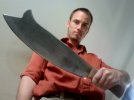Depends on the grind. On a scandi, 3/32" is perfect but this is too thin for full flat or full convex simply because the spine won't be that thickness. On full flat, I really like 5/32" but 1/8" can be awesome depending on how aggressive the maker gets with the grind. I.e. 1/8" can be too thick if the transition to the secondary bevel is not aggressive enough or right. Similarly, 5/32" can provide an amazing knife if the propoer controls on a flat or convex grind are performed to get the primary bevel edge thickness to the right value and when done too aggressively won't be robust enough.
Over time, this is how I learned Bark River can make a knife with slightly less than 1/4" thickness at the spine slice like a demon while a knife maker working 1/8" stock thickness who puts less attention on the grind angles and thickness at the primary bevel produces a clunky slicer. Its also the reason why a thick Barky will chip out under less abuse than the same 1/8" thickness stock described above.
So appropriate thickness for a bushy knife? All depends on the maker and your use patterns my friend.










